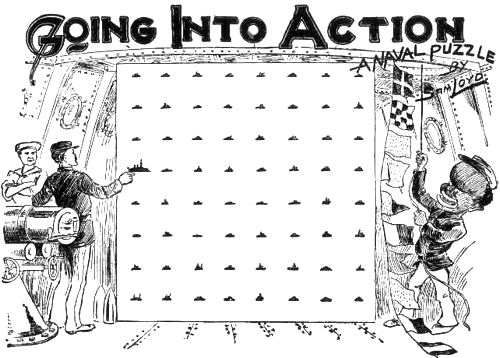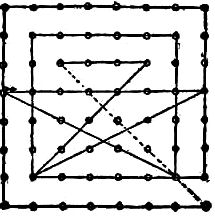



THE ACCOMPANYING sketch show’s little Cinch running up the signal of battle, which for the benefit, of such as are not familiar with the naval code of signals, will be explained to represent the once famous battle cry during the American-Spanish war, “Remember the Maine!” The commander is shown to be mapping out the plan of attack by which he designs to ram and run down the flotilla of the enemy’s gunboats, so as to destroy them with the greatest possible dispatch. Commencing at the point occupied by the large battleship, mark out with one continuous line, the 63 little boats and return to starting point, after making the fewest possible number of “straight” moves, as we would term it in puzzle language.
In this naval problem, wherein it was required to show the fewest possible number of moves whereby Uncle Sam’s battleship could run down and destroy the sixty-three vessels of the enemy, it may be said that there are many simple ways of performing the feat in from fifteen to eighteen moves, but the following plan in fourteen moves, returning to starting point, seems to be the best possible answer:

2. The Break-Up of the Conundrum Club.
I have always been very partial to conundrums, and am firm in the belief that there are about thirteen million excessively stupid people, who fail to appreciate a joke or anything that is good, who would have become more entertaining members of society if, in their younger days, they had digested conundrums. But, as I was going to say, I am no longer the president of the Conundrum Club, for the reason that the organization broke up in a row, as follows:
You see, Smith, who at heart is a capital fellow, came into the rooms one evening and says: “I've got a good one.”
“What is it?” we all queried.
“When is an apple pie?” He stopped, and every one looked at him expectantly, but said nothing.
“Well,” finally queried a man across the room, “go on, what did you stop there for?”
“Go on? Go on with what?” he asked.
“Why, go on with your conundrum. ‘When is an apple pie what?’”
"That's what I said,” replied Smith.
“Yes, we know; but what is the conundrum? ”
“When is an apple pie?”
“There is no sense in that,” said several; “give us the rest.”
“There isn't any rest,” said Smith. “When is an apple pie?”
“When is an apple pie what? You gump?” yelled several from all parts of the room.
“Who said ‘apple pie what?’”
“You did.”
“I didn't say any thing about apple pie what?”
“You did.”
‚ÄúI didn't; you‚Ä”‚Äù
But his remarks were never concluded, as the whole assembly undertook to eject Smith, who was somewhat of an athlete, and even after the police hail restored order it took several hours to explain that an apple was pie when sweetened and flavored and enclosed in crust, but there were too many sore heads to hold the club together after that, fateful conundrum.
3.
What is the difference between a cat and a comma? A cat has its claws at the end of its paws, while a comma its pause at the end of a clause.
When is a boat like a heap of snow? When it is adrift.
[Page 189]